
foreword | Historical Narratives | Resources | Links | Contact
Character and Chance at Grips with Destiny.
"The purpose of writing is to narrate, not to prove."
Quintilian
 |
At just a tiny spot on the world map - the Heights of Abraham - two generals died on the field of honour and the political face of the world was changed forever. The battle on the Plains of Abraham lasted only twenty minutes, but that brief phase of fighting is looked on as a turning-point in history, an epoch-making milestone. This great eighteenth century event resulted in half of North America being lost and won. In a stroke Britain had taken possession of a continent.
The conflict has echoed and re-echoed down through modern history and the battle and its battlers subjected to a plethora of post mortems. What transpired on that battlefield was so legendary that fact and fancy have collided and colluded ever since. The plains are laden with history where Francophones and Anglophonbes have shared emotions. Personalities, chance, blunders and bravery shaped the outcome and as soon as the fighting finished, the manufacture of mythologies began. Through the altering miracle of myths the leaders were lionized and their actions and accomplishments embellished and exaggerated with each telling. It is said that to do justice to a great man discriminating criticism is always necessary and such certainly has been the case with our heroes in this instance.
Because time with its eradicating eraser diminishes and then obliterates all earthly fame, Herodotus, the father of historians, sought to maintain the memory of the military by "preserving from decay the remembrance of what men have done" in the grit and grime of human suffering. Like Herodotus succeeding historians cull and dissect details from historical records as they seek to vilify or vindicate commanders who lost or won.
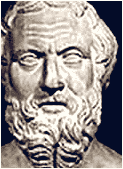 |
|
Herodotus |
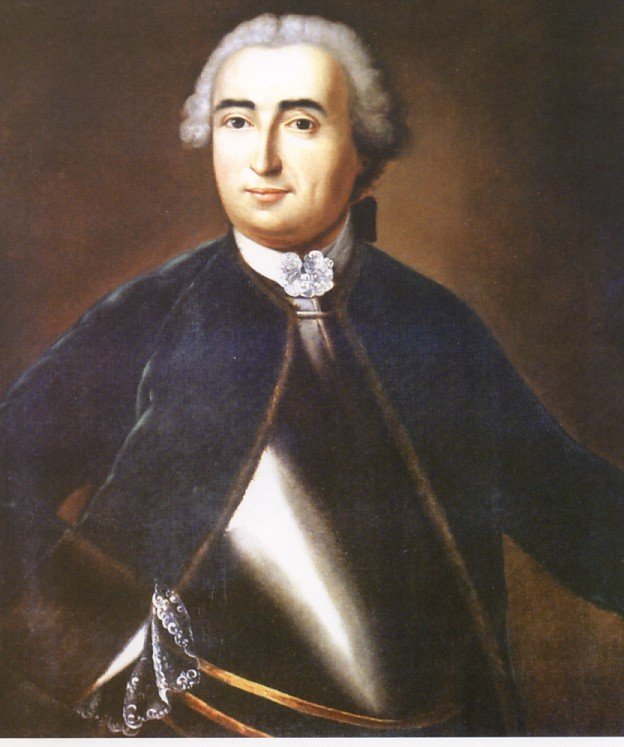 |
|
Montcalm |
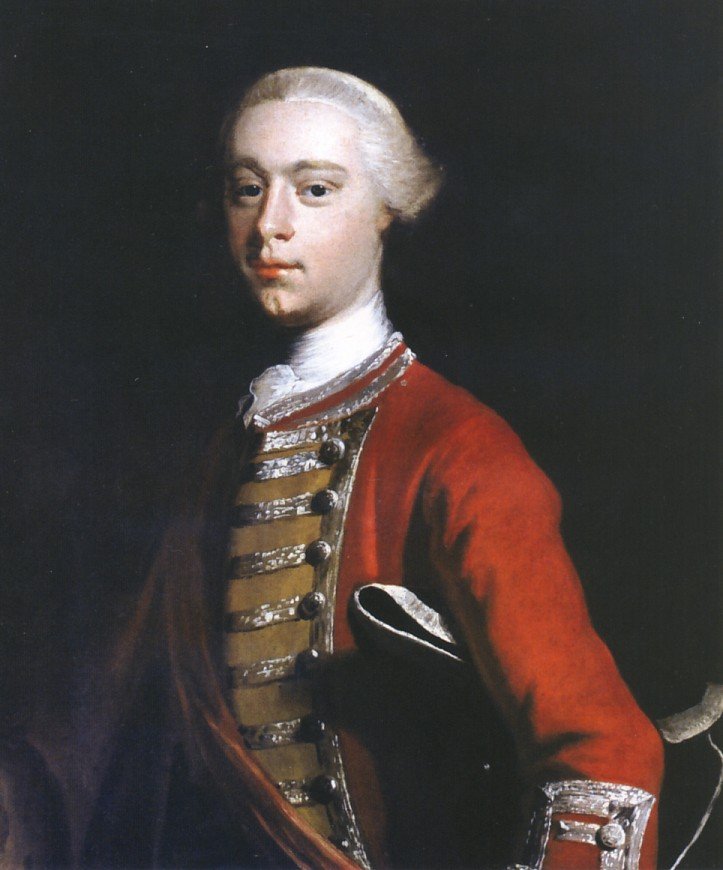 |
|
Wolfe From Painting by Joseph Highmore [24] |
While Wolfe and Montcalm remain dim figures to us, they were real men with real problems. They were ambitious and courageous individiuals, both seeking to find their own fortunes and to serve as faithful stewards of their nations. At the moment of crisis they were there but their attitude and their outlook on war were very different. Wolfe was eager and merciless, while Montcalm, who had been wounded six times, had cooled to confict.
Montcalm galloped along the lines on his black steed, stirring up his soldiers facing a fiery foe. Not far away Wolfe, the spindly, scarlet-coated commander, looked over his legions on foot, directing with his walking stick. These men had one thing in common: they were leaders who led from the front, easy targets for the taking. .
In wartime a man must do his duty as he sees it and take his luck as it comes or goes. Whether Wolfe is judged to be a hero or a head case and Montcalm a knight or a numbskull they will be inseparably connected as long as history is written. They had in common many of the qualities which meld to produce military greatness. Their deaths were certainly worthy of warriors. Both died in command on the field of battle, a great cause being contested with intense fighting raging around them with the vanquished and the victor displaying valour that day that will be commemorated for as long as Canada endures.
The search for a national hero does not lead far from fighting. According to one military historian this results "from the deliberate sense of duty which once formed the spine and dynamic of that commanding presence." However, as heroes cool in time ragged edges and faults appear and along with the cracks come criticisms.
While the daring displayed by those doing the fighting was heroic, the outcome of the conflict may have had more to do with misjudgments of the generals. In war nearly everything is a matter of hazard. Both men made mistakes, but then so do all successful generals. In the 18th century victory often went to the general who made the fewest mistakes.
The battle scene has been reconstructed and analyzed many times in the glare of history. How has this searching scrutiny moulded the memory of these two men whose actions led them to glorious doom? The re-examination of lives lived and the circumstances surrounding their existence reveals fresh insights and sheds new light on the past resulting in reputations that ebb and flow.
No matter how golden the head of a hero his feet can become common clay. In recent times historians have concentrated more on the clay and produced histories debunking heroes by stressing their faults and frailties. All are fallible, of course, and few doubt that there were lights and shadows in the characters of both these heroes. While some assail any debate that demeans these brave men, others seek any sign at all that casts doubt on judgements that laud these leaders.
Historians are divided as to their assessment of Montcalm. Some support the sentiments inscribed on the plaque on the Plains of Abraham: that he was "a gallant, good and great man." These are historians "for whom defending Montcalm is largely a matter of repeating Montcalm," that is, endorsing his accounts of his time in Quebec. Others credit Montcalm with some notable victories but argue that in the big battle he lacked "the invaluable ability to penetrate Wolfe's intentions." No less a leader than Napoleon stated, "The most difficult thing is to discern the enemy's plans and to detect the truth in all the reports one receives. The remainder requires only common sense." A common military maxim is "Know thine enemy."
Montcalm position was strong: he outnumbered Wolfe, he was behind fortifications and his best troops were not far upcountry ready to take the British in the rear. But Montcalm too though gallant and attractive was not a gifted general. He distrusted all Canadians and resolved to come out fighting at once before his militia could run away. In the ensuing battle the French were broken, both generals were killed and Quebec surrendered shortly thereafter. No campaign better illustrates the maxim that wars are won by those who make the fewest blunders.
If Montcalm had anticipated Wolfe's actions he would doubtless have been able to quickly quash his assault. Even after Wolfe's forces gained the Heights and formed into line of battle, Montcalm could still have controlled events by making Wolfe come to him. Caution in the face of such an enemy would have been wise. Montcalm could afford to wait; Wolfe could not. Montcalm had more to gain by manoeuvre than by combat. A long siege was impossible because the British had few rations, little in the way of supplies, no reserves and no surgeons. Even if more supplies had been available hauling them up the heights would have been a daunting task. Only two or three weeks remained before the freeze up and the withdrawal of the British fleet. No more materiel or reinforcements could be expected until spring. It is said that a good military leader instinctively knows that the availability of ample provisions is not something to be trifled with or left to chance. On the other hand no human activity is so continuously or universally bound up with chance. According to Karl Von Clausewitz, a great military strategist, "he who never leaves anything to chance will do few things ill but he will do few things."
Looking back with the vision of hindsight opportunities for success existed but they were cast away by mistakes and mischances. If Montcalm had avoided a major engagement for a few days Wolfe would have been forced to withdraw from the field making a ragged retreat down a steep bank, there to await at the water's edge the uncertain arrival of boats to rescue them from their very vulnerable position. All the while Canadian sharpshooters would have been able to pick them off at a leisurely pace.
Instead of remaining securely behind the walls of Quebec and out-waiting Wolfe Montcalm decided to confront his adversary on the field of battle. Even that decision might have been militarily defensible had Montcalm delayed challenging Wolfe until he had surrounded British forces from the east and the west as Vaudreuil recommended. Montcalm had some 6000 troops at Quebec and a force of 3000 more readily available several kilometres above Quebec. Wolfe's army was sandwiched in between. The lessons of military history and the practice of great commanders have all accentuated the principle "that everything should be massed for the battle. With the enemy almost at his mercy Montcalm did the one thing he should have avoided doing: ordered his troops to attack the British lines. Without stopping to take stock, consult with Vaudreuil or seriously discuss tactics with his own staff, Montcalm launched an ill-conceived strike with an inappropriate mix of inadequate forces. Not only did Montcalm err in fighting a set piece battle, he compounded the foul-up by fighting with only half his forces.
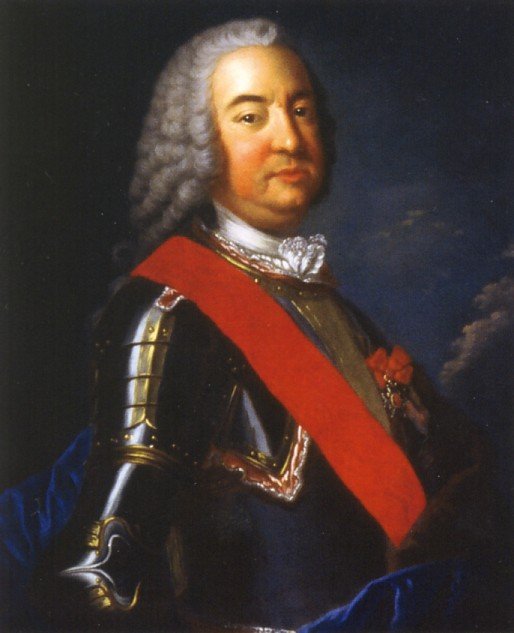 |
|
Francois-Pierre de Rigaud de Vaudeuil, last governor of New France |
Montcalm's military comprised a motley mix of French regulars, untrained Canadian militia and Aboriginal warriors, a volatile blend of men to make a frontal assault on an open field against a superior force of highly trained, disciplined British regulars. Montcalm's mixture exemplified his failure to remember the fundamental differences in mind-set and methods between regulars and militia. As a consequence Montcalm is charged with one of the most disastrous defeats in Canadian history. If he had had less pride and more common sense and had executed his assault as he ought to have, he might very well have been the victor rather than the victim. "However absorbed a commander may be in the elaboration of his own thoughts it is sometimes necessary to take the enemy into account."
Montcalm could not have lured Wolfe into a better trap than the one Wolfe selected for himself. Instead of making the most of his situation Montcalm threw away his advantages by choosing to fight Wolfe on Wolfe's terms. Few generals have ever so completely burned their bridges. As the author of his own misfortune Montcalm's befuddled tactics turned the British conquest into a fortuitous triumph.
In fairness it should be recognized that Montcalm had to fight on two fronts for he was menaced also from within. Some attribute his defeat to this fact. Wolfe besieged him from outside, while Bigot and Vaudreuil beggered and badgered him from the inside. Because of internal conflict and corruption it could be argued that Montcalm's downfall was inevitable. "Montcalm lost the most critical battle because he was too honest to consort with crooks." While this was a worthy reason it has been charged that Montcalm was motivated to make his precipative attack on less laudatory grounds - jealousy. Montcalm was jealous of Vaudreuil who was not yet on the field and if Montcalm managed to win before his hated rival appeared, the glory would be his and his alone.
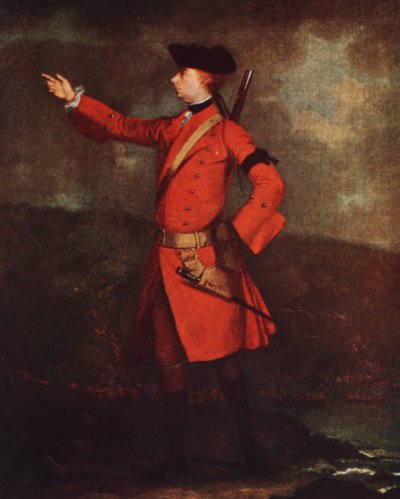 |
|
Wolfe, The Dauntless Hero Came |
Following Wolfe's victory and death at Quebec his illustrious memory was chereished by the people of England. Criticism of him was considered tantatmount to blasphemy. He was a hero and he was dead and of such men nil nisi bonum. (nothing except good) History has been overly kind to Wolfe and until this century he was a legendary figure in Canadian history. Some historians have now begun to question this favourable depiction and the portrait previously drawn of him. They maintain his action that day was nothing more than a reckless grab for glory. His daring might well have led to disastrous blunder but fate was steady and saw him safely through. "The special star that shines on great commanders bathed him in its light."
Wolfe was bold to the point of rashness and only favourable fortune - and a timely death - account for his reputation for tactical brilliance. British success on the Plains of Abraham was due more to Wolfe's luck than his leadership. He owed much to kindly providence but then so do all victorious generals. Wolfe sought no one's advice and asked no one's opinion. His own officers were ignorant of his plans. All Monckton knew of Wolfe's scheme was that he intended "to land where the French least expect it." When Townshend and Murray begged Wolfe to be more precise he silenced them with the curt comment that he hoped he had chosen the right spot. "If I am mistaken, I am sorry for it." In the duel of arms and wits Wolfe was about wage, he was gifted with that magic faculty to emerge invincible from disaster.
In assembling his army on the plains Wolfe placed his men in appalling peril. Retreat would have meant flight down a steep cliff and a nerve-racking wait at the bottom on a narrow beach for the arrival of rescue boats to remove them. There was no other means of escape. The only other alternatives were capitulation or death by drowning, bullet or bayonet. Wolfe had violated one of the first rules of a well-run campaign: never place yourself in a position from which there is no avenue of retreat. An added peril resulted when Wolfe decided to place his men between two French armies: Montcalm's forces and the French soldiers who were located upriver to prevent the English from landing there. Without rescue boats few of the British soldiers would have found their way back to the fleet which would have been forced to return to England with only the shattered regimental remnants. "Wolfe dug a grave for his army; Montcalm marched his own men into it."
On the other hand perhaps Wolfe was adhering to the military strategy advocated by Sun Tzu: "Throw your soldiers into positions whence there is no escape and there is nothing they may not achieve. Officers and men alike will put forth their uttermost strength. Soldiers in desperate straits lose the sense of fear. If there is no place of refuge they will stand firm."
In any case history frequently forgives those who dare too much too soon. Thus it was with Wolfe who gambled greatly and won. He profited as much from his enemy's errors as from his own decisions, but then few generals do not. "Wolfe won because the failings of others affected circumstances, and because he was already certain of his fate he was characteristically brave and brash. According to Winston Churchill, "No one can guarantee success in war, only deserve it." The battle was fought between heroes of equal brilliance but unequal fortunes. In the duel of arms and wits Wolfe waged, he showed himself adroit, gifted and fortunate with the magic faculty to emerge invincible from disaster.
A fair verdict seems to be that Wolfe was an indifferent strategist but a good tactician and a superlative personal leader. What he accomplished he worked for. If at last luck helped him he always had an almost uncanny sense of what he called "the lucky moment in war." Wolfe had recently written letters reflecting black pessimism and on this occasion he found it hard to believe his own good luck. Coupled with Wolfe's good fortune was the superb cooperation between the army and the navy. It was admirable throughout this classic amphibious operation. Then, of course, there was the "thin red line" which held firm against the oncoming columns of French infantry. Many considered a well-led, disciplined line of British infantry to be impregnable because of its calm tenacity and its superior aim in firing. "Soldiers win battles; generals get the credit for them."
Wolfe's claim to fame lies in the success of a single campaign during which he was killed. If greatness lies in the ability to overcome all obstacles Wolfe was indeed great. He fought against continuous ill-health, attendant pain and a deadly disease ravaging his body. He overcame great difficulties and outwitted one of the finest French generals of his time. Wolfe's reward was a great victory. He wanted no other.
Despite his lapses as a leader on the Plains of Abraham history is justified in sounding bugles for the defeated Montcalm. A plaque on the Plains of Abraham commemorates him.
Montcalm
Quatre fois victorieux
Une fois vaincu
Toujours au grand honneur de la France
Blesse a mort ici le 13 septembre 1759
Montcalm
Four times victorious
Once vanquished
Always to the great honour of France
Wounded and died here 13th September 1759
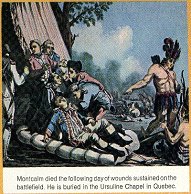 |
|
Death of Montcalm |
"Seek out - less often sought than found -
A soldier's grave, for thee the best;
Then look around, and choose thy ground,
And take thy rest."
Lord Byron
In 1859 on the one-hundredth anniversary of Montcalm's death a commemorative plaque was dedicated in the chapel in which he was buried. It bears the words:
Honour to Montcalm
Destiny
Denied Him Victory.
He was Rewarded
With a Glorious Death
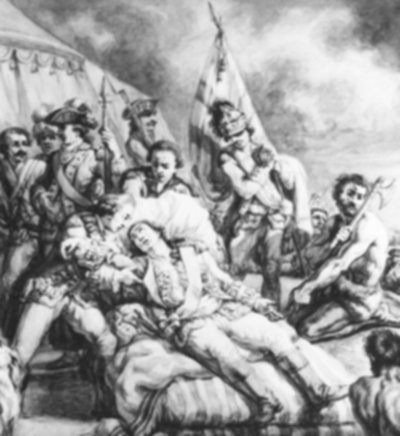 |
|
The Death of Montcalm |
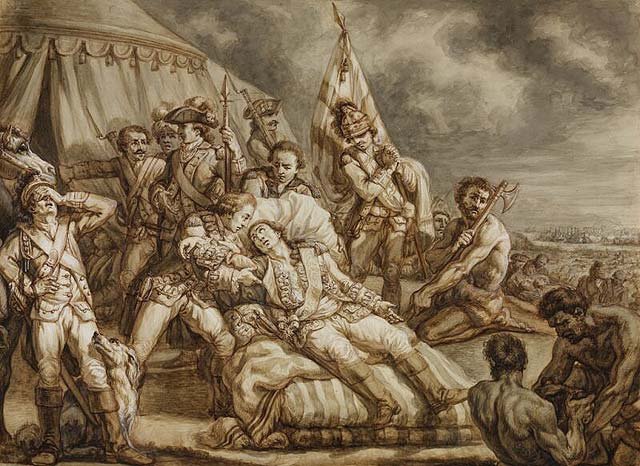 |
|
Fanciful version of the Death of Montcalm by François-Louis-Joseph Watteau {The original is in the National Gallery of Canada} [Inspired by West's Painting of the Death of Wolfe] [***] |
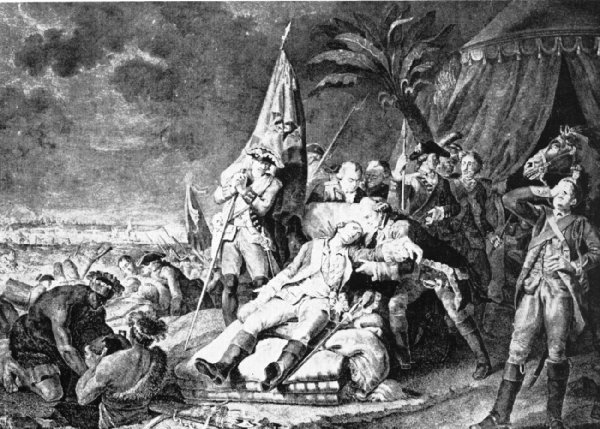 |
|
Death of Montcalm by François-Louis-Joseph Watteau This painting is even more inaccurate than West's. Montcalm did not die on the field of battle and Canada does not have any palm trees. |
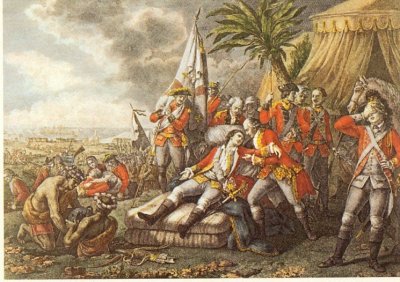 |
|
Death of Montcalm by François-Louis-Joseph Watteau [The Seven Years' War by Rupert Furneaux] [***] |
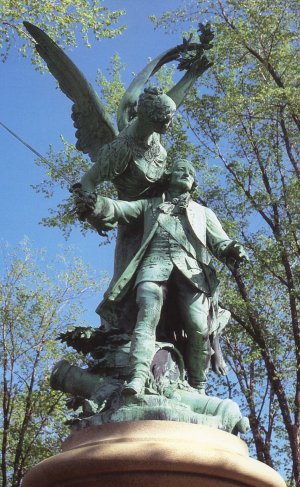 |
|
Monument to the Memory of Marquis Louis-Joseph de Montcalm (Presented to Quebec City by France and inaugurated on Oct. 16, 1911, it portrays a mortally wounded Montcalm supported by an angel. It is a replica of one erected at Vauvert, a few kilometres from Nimes, Montcalm's birthplace. |
On the Plains of Abraham a simple shaft marks the spot where Wolfe fell.
Its inscription bears four words.
justify
Here Died Wolfe Victorious.
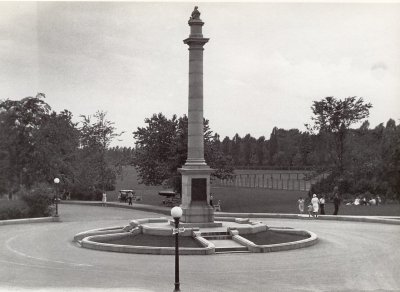 |
|
Wolfe Monument 1935 (NBC) |
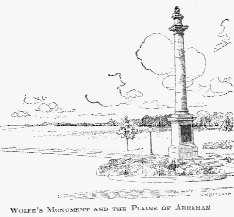 |
|
Wolfe's Shaft |
Stop, passenger!
And here view whatever is grand and noble,
Summed up in the character
of
James Wolfe
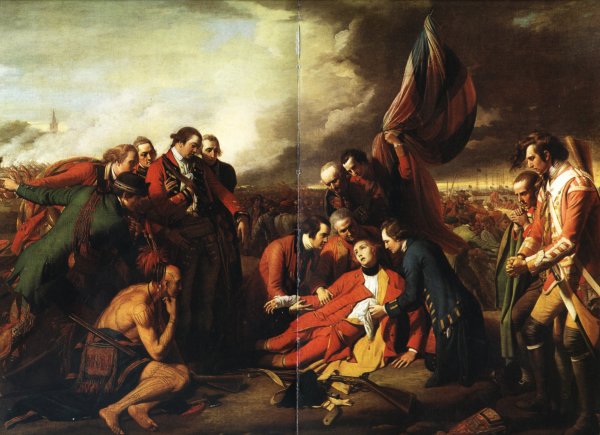 |
|
The Death of Wolfe |
"Seek out - less often sought than found -
A soldier's grave, for thee the best;
Then look around, and choose thy ground,
And take thy rest."
Lord Byron
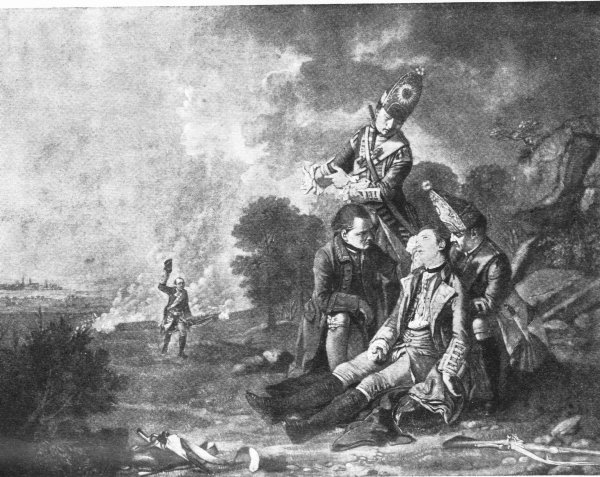 |
|
The Death of Wolfe |
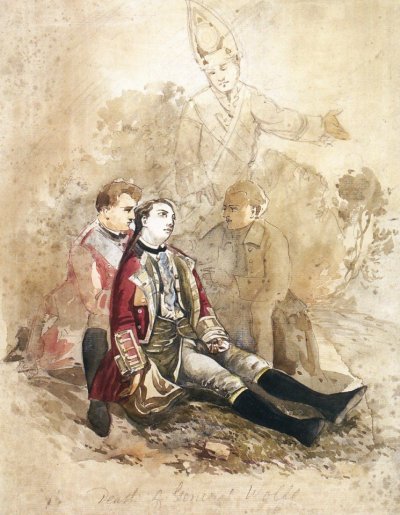 |
|
Death of Wolfe |
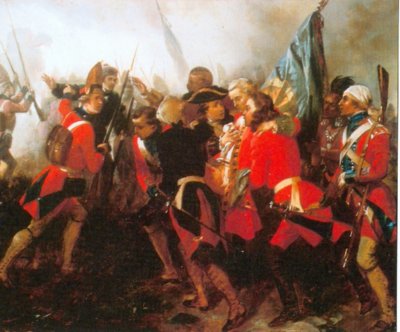 |
|
Death of General Wolfe |
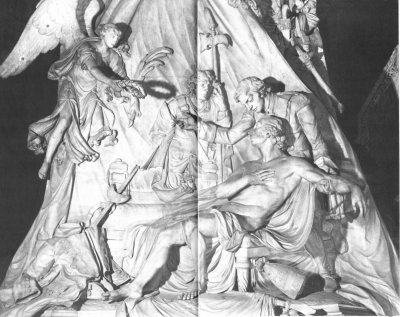 |
|
Wolfe's Dramatic Demise |
Hero status is granted not gained. A grateful nation has made Montcalm and Wolfe renowned Canadian heroes made immortal by the magic power of patriotism. On the second floor in Canada House in Britain off London's Trafalgar Square, bronze statues of Wolfe and Montcalm, whose very presence personifies the Canadian experiment, flank the entrance to the High Commissioner's office. This tribute honours both of Canada's military heroes whose death launched our destiny. In Quebec City a monumental spire commemorating the two great commanders is located just west of the Chateau Frontenac Hotel. The tall, stone shaft bears the name Montcalm on one side and Wolfe on the other. Engraved on the pedestal are the words
Courage gave them a common death
History a common fame
Posterity a common monument.
The two great men never met, but if they had it is not improbable to suppose to paraphrase Dryden, the long-inveterate foes would have saluted as they passed.
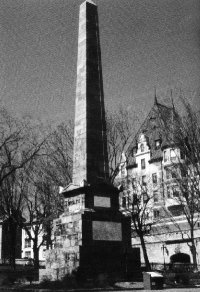 |
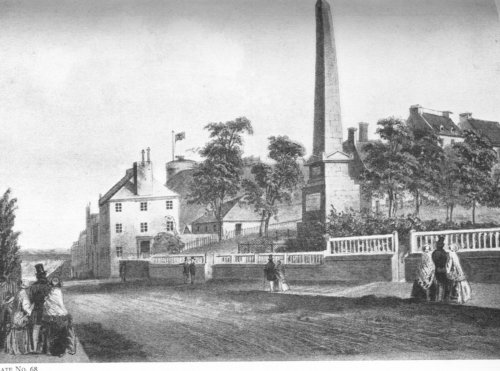 |
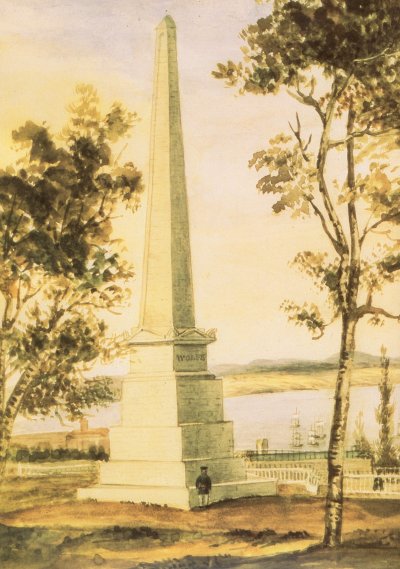 |
|
The cornerstone for this Neoclassical obelisk twenty metres high designed by Captain Young was laid by Lord Dalhousie on November 15, 1827. It honours both heroes of the Battle on the Plains of Abraham. (M.M.Chaplin, NAC) |
Charles Dickens visited Quebec City in 1842 and was enchanted with this Gibralter of America." "The dangerous precipice along whose rocky front Wolfe and his brave companions climbed to glory. The Plains of Abraham where he received his mortal wound. The fortress so chivalrously defended by Montcalm, and his soldier's grave dug for him while yet alive by the bursting of a shell." Dickens was impressed with their joint monument and described the battle and the death of Montcalm and Wolfe as "one of the gallant incidents of history."
In His Own Words"That is a noble Monument too and worthy of two great nations which perpetuates the memory of both brave generals and on which their names are jointly written."
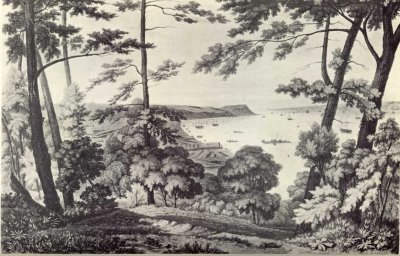 |
|
Wolfe's Cove |
The names and the fame of Montcalm and Wolfe live on in their descendants - Baron Georges Savarin de Marestan and Andrew Wolfe Burroughs. They have dedicated themselves to perpetuating the memory of their illustrious ancestors through a charitable trust set up in France to foster continued interest in the Wolfe-Montcalm heritage. Mr. Burroughs, a BBC journalist, says he fell in love with Quebec on his first visit in 1997. He is also a member of a musical group he calls Trip Wolfe which will participate in a concert series for the National Battlefields Commission and perform on the Plains of Abraham a few hundred metres from where his ancestor died. Mr. Burroughs is the official family representative of Britain's Wolfe Society whose purpose is to keep the memory of James Wolfe alive.
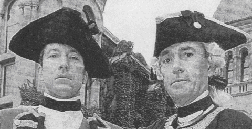 |
|
Descendants of Wolfe and Montcalm: Baron Georges Savarin de Marestan & Andrew Wolfe Burroughs |
Montcalm and Wolfe!
Wolfe and Montcalm!
Quebec, thy storied citadel
Attest in burning song and psalm
How here thy heroes fell!
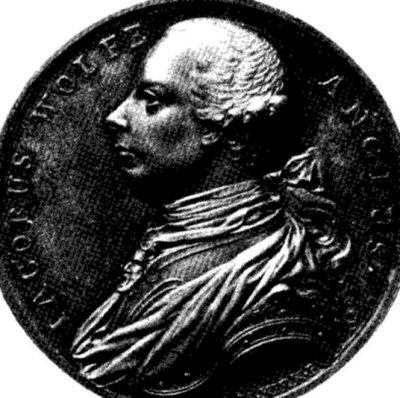 |
|
Quebec Commemoration Medal |
The most dramatic of the paintings was Benjamin West's famous but factually faulty the Death of Wolfe. West's version was considered the definitive image of the fallen hero. The painting's furled flag directs our eyes to the dying Wolf. Watching helplessly are two foot soldiers, their hands clasped in prayer, overcome with grief. Over all hangs a foreboding black cloud. The picture, painted in 1769, created a sensation at the Royal Academy in London where long lines of eager viewers turned out for its unveiling in 1771. It became so popular West painted five similar versions for wealthy patrons including King George III.
It roused emotion in all who saw it including the great Lord Nelson, who told West he would always stop to look at the Death of Wolfe if he saw it in the window of a print shop. Nelson asked West why he had not painted more such works. "Because, my lord, there are no more subjects." "I didn't think of that," said Nelson. But said West "Should your intrepidity furnish me with another such scene, I will paint it." "Will you Mr. West? Then I hope I die in the next battle."
Three of those portrayed by West in the painting were actually there. The others each paid West a hundred guineas for the honour. Only Lieutenant Browne, who holds the standard and Grenadier Henderson on the extreme right were definitely identified. Wolfe died with only four aides in attendance. Samuel Holland, a surveyor after whom Holland Landing north of Toronto is named, was present during the Battle of the Plains of Abraham.[****] Holland returned to Wolfe's side from a dangerous engineering operation only to find him dying. Wolfe must have been on friendly terms with Holland for he gave him a pair of dueling pistols, a gift that was to bring heartbreak to Holland for his 19-year old son was killed later fighting a duel with the pistols.
Holland made the following comment regarding the painting. "In the battle of September 13, I lost my protector (Wolfe) while holding his wounded hand at the time he expired. For reasons best known to Mr. West, the painter, I was not included amongst the group represented. Others exhibited in that painting were never in the battle." This latter statement conflicts with information which indicated that Moncton was the only brigadier willing to be depicted in West's painting as one of those clustered about Wolfe when "his valiant spirit fled." The scholar James Young has written about public monuments. "Were we to passively remark only on the contours of these monuments and memorials, were we to leave unexplored their genesis and remain unchanged by the recollective act, it could be said that we have not remembered at all." [**] Edward Penny's painting of the Death of Wolfe is the more accurate of the two paintings. It depicts Wolfe's last moments being supported by two soldiers as another regular runs towards him with news of the flight of the French. [****] The Plains of Abraham - a work of nature, time and human beings - combines natural beauty and historic value.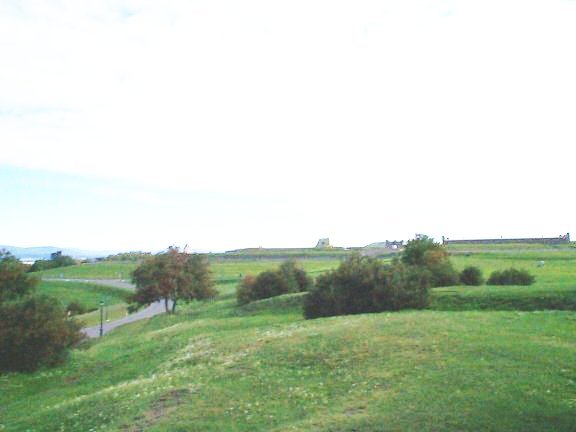 |
|
Scene of Death and Destruction Now Silent and Serene 2000 |
Today is Sunday, 13 September, 2009, 250 years to the day (it was a Thursday then) of the Battle on the Plains of Abraham. A re-enactment of that military milestone was planned by Quebec history buffs in colourful costumes on the self-same site of the struggle. The very suggestion of any such simulation infuriated a number of Nationalists, who voiced violence at even the hint of history's re-enactment. Amazingly, France's defeat still festers with a few die-hards, so with the threat of havoc haunting the heralded site of that historic scene, the event was cancelled.
Those who objected to having history re-played on the Plains, decided to pay homage to that historic happening by reading notes from the news that has taken place since that great English victory. Even this passive pursuit raised the rankles of some, who objected to that rendering including a recounting of the violent episode known as The FLQ Crisis, during which Prime Minister Pierre Trudeau called out the army and arrested a number of agitators. Astounded on that occasion by what he thought was the PM's abominable behaviour, a nervous newsman queried of the Prime Minster what more madness he intended to inflict on Canadians. A furious Pierre famously fumed to the reporter and all other 'bleeding hearts'."Just watch me."
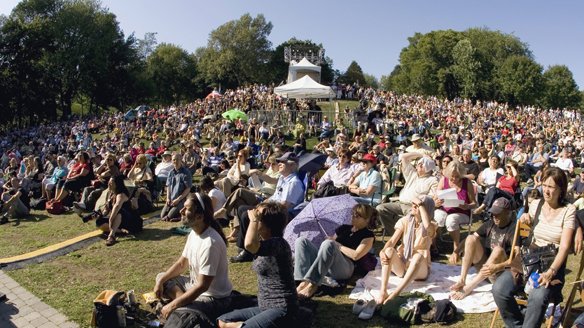 |
|
Crowds on Plains of Abraham Listening to the Reading |
Plains of Abraham reading attracts thousands
Sundayaturday, September 13, 2009
People attend Moulin a Paroles Saturday on the Plains of Abraham in Quebec City. (Jacques Boissinot/Canadian Press)
Thousands of people gathered Saturday on the Plains of Abraham in Quebec for a commemoration that became controversial over the inclusion of an FLQ document. The Moulin à paroles is a 24-hour read-a-thon that marks the 250th anniversary of the British military victory on the Plains, a battle that ended France's power in what became Canada. The weekend event in Quebec City features readings from 140 texts relating to the province's history from the battle in 1759 to the present.Among the dozens of old letters, essays and speeches is the nine-page 1970 manifesto of the Front de Libération du Québec (FLQ). The manifesto was broadcast nationwide during the October Crisis by pro-independence kidnappers as a list of demands in exchange for the return of a captured British diplomat. The decision to include the manifesto led most federalists to boycott the event. Quebec Premier Jean Charest said his government isn't participating because the inclusion of the FLQ document is simply too upsetting for too many Quebecers. Sovereigntist politicians are attending in large numbers, including Bloc Québécois Leader Gilles Duceppe and Parti Québécois Leader Pauline Marois. They called the federalist boycott ridiculous, saying the October Crisis, as disturbing and violent as it was, remains a key chapter in Quebec's history. Moulin organizer Pierre-Laval Pineault said he didn't expect any disruptions despite the controversy. "We expect a peaceful event," he said. However, Pineault said the uproar over the reading of the FLQ manifesto came as a surprise. "We were naive about this controversy. We didn't expect this kind of controversy." he said.
Copyright © 2013 Website Administrator